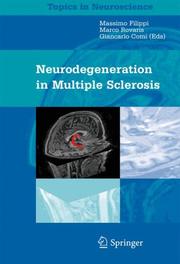| Listing 1 - 4 of 4 |
Sort by
|

ISBN: 1281206563 9786611206567 8847003911 8847003903 8847055830 Year: 2007 Publisher: Milan : Springer,
Abstract | Keywords | Export | Availability | Bookmark
 Loading...
Loading...Choose an application
- Reference Manager
- EndNote
- RefWorks (Direct export to RefWorks)
In multiple sclerosis (MS), conventional magnetic resonance imaging (cMRI) has proved to be a valuable tool to increase diagnostic reliability and to monitor the efficacy of experimental treatment. However, cMRI has limited specificity and accuracy as to the most disabling aspects of the MS pathology, known to occur in and outside macroscopic lesions. Modern quantitative MR techniques have the potential to overcome the limitations of cMRI, and their application is dramatically changing our understanding of how MS causes irreversible disability. Written by world-renowned scientists, the volume is indispensable for anybody working in this field.
Magnetic resonance imaging. --- Multiple sclerosis --- Nervous system --- Diagnosis. --- Pathophysiology. --- Degeneration --- Organs (Anatomy) --- Neurosciences --- MS (Disease) --- Sclerosis, Multiple --- Demyelination --- Myelin sheath --- Virus diseases --- Clinical magnetic resonance imaging --- Diagnostic magnetic resonance imaging --- Functional magnetic resonance imaging --- Imaging, Magnetic resonance --- Medical magnetic resonance imaging --- MR imaging --- MRI (Magnetic resonance imaging) --- NMR imaging --- Nuclear magnetic resonance --- Nuclear magnetic resonance imaging --- Cross-sectional imaging --- Diagnostic imaging --- Diseases --- Diagnostic use --- Neurology. --- Neurosciences. --- Radiology, Medical. --- Nuclear medicine. --- Imaging / Radiology. --- Neuroradiology. --- Nuclear Medicine. --- Atomic medicine --- Radioisotopes in medicine --- Medical radiology --- Radioactive tracers --- Radioactivity --- Clinical radiology --- Radiology, Medical --- Radiology (Medicine) --- Medical physics --- Neural sciences --- Neurological sciences --- Neuroscience --- Medical sciences --- Medicine --- Neuropsychiatry --- Physiological effect --- Neurology . --- Radiology. --- Radiological physics --- Physics --- Radiation --- Neuroradiography --- Neuroradiology
Book
ISBN: 9780521888325 9780511781698 Year: 2010 Publisher: Cambridge Cambridge University Press
Abstract | Keywords | Export | Availability | Bookmark
 Loading...
Loading...Choose an application
- Reference Manager
- EndNote
- RefWorks (Direct export to RefWorks)
"Recent developments in basic and applied science have led to better understanding of disease mechanisms and more efficient therapies for multiple sclerosis. The most effective way of managing these patients is through a carefully planned neurorehabilitation programme. The main aims are to reduce disability and handicap and improve functions through effective training, stimulating activity and social participation. As the first text on recovery of function and neurorehabilitation in MS, this book focuses on mechanisms of recovery, application of neuroplasticity to therapeutic interventions, and determination of the efficiency of these interventions. Basic principles of neurorehabilitation in MS are described, as well as techniques for treating specific syndromes which may occur in MS. Written and edited by leading clinicians and researchers, the book achieves an excellent balance between basic science, pathophysiology, and clinical rehabilitation. An essential resource for clinicians and therapists treating patients with multiple sclerosis, neurophysiologists, and health care advisors"--Provided by publisher.
Book
Year: 1995 Publisher: London Taylor & Francis
Abstract | Keywords | Export | Availability | Bookmark
 Loading...
Loading...Choose an application
- Reference Manager
- EndNote
- RefWorks (Direct export to RefWorks)
Book
ISBN: 0511850948 1107219280 1283050072 9786613050076 0511909136 0511781695 0511909888 0511907087 0511905807 0511908385 Year: 2010 Publisher: Cambridge : Cambridge University Press,
Abstract | Keywords | Export | Availability | Bookmark
 Loading...
Loading...Choose an application
- Reference Manager
- EndNote
- RefWorks (Direct export to RefWorks)
Recent developments in basic and applied science have led to better understanding of disease mechanisms and more efficient therapies for multiple sclerosis. The most effective way of managing these patients is through a carefully planned neurorehabilitation programme. The main aims are to reduce disability and handicap and improve functions through effective training, stimulating activity and social participation. As the first text on recovery of function and neurorehabilitation in MS, this book focuses on mechanisms of recovery, application of neuroplasticity to therapeutic interventions, and determination of the efficiency of these interventions. Basic principles of neurorehabilitation in MS are described, as well as techniques for treating specific syndromes which may occur in MS. Written and edited by leading clinicians and researchers, the book achieves an excellent balance between basic science, pathophysiology, and clinical rehabilitation. An essential resource for clinicians and therapists treating patients with multiple sclerosis, neurophysiologists, and health care advisors.
Multiple sclerosis. --- Multiple sclerosis --- Patients --- Rehabilitation.
| Listing 1 - 4 of 4 |
Sort by
|

 Search
Search Feedback
Feedback About UniCat
About UniCat  Help
Help News
News